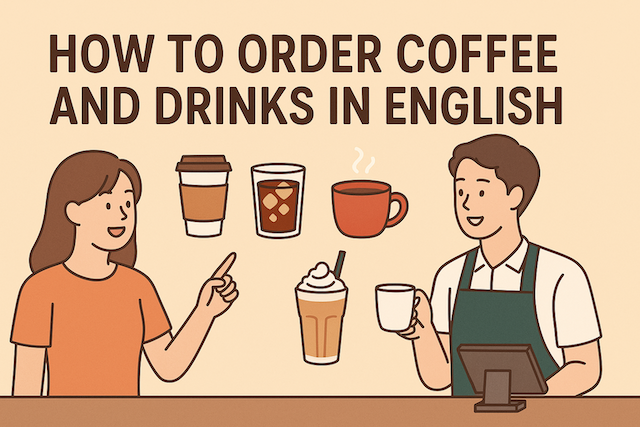How to Order Coffee and Drinks in English

Contents
How to Order Coffee and Drinks in English
Ordering coffee or drinks in English may seem simple, but if you are a learner or a traveler, it can feel intimidating. Cafés, coffee shops, and bars often have fast-paced environments, with staff using phrases that might be difficult to catch. Knowing the right vocabulary and expressions will help you feel confident, polite, and natural when ordering. In this guide, we will cover useful phrases, example dialogues, and cultural tips so you can smoothly order coffee and drinks in English.
1. Basic Vocabulary for Ordering
Before practicing sentences, it helps to know some essential vocabulary:
-
Types of Coffee: espresso, cappuccino, latte, americano, mocha, macchiato, cold brew.
-
Sizes: small, medium, large (in Starbucks and some cafés: tall, grande, venti).
-
Temperature: hot, iced.
-
Add-ons: extra shot, whipped cream, syrup (vanilla, caramel, hazelnut), oat milk, almond milk, soy milk.
-
Sweetness levels: no sugar, less sugar, regular, extra sweet.
For drinks other than coffee, you may need:
-
Soft drinks: Coke, Sprite, soda water, lemonade.
-
Juices: orange juice, apple juice, mango juice.
-
Alcoholic drinks: beer, wine, whiskey, cocktail, gin and tonic, margarita.
2. Common Phrases for Ordering
When you approach the counter or speak to a waiter, here are standard polite expressions:
-
To order coffee:
-
“Can I have a cappuccino, please?”
-
“I’d like an iced latte with oat milk.”
-
“May I get a small black coffee, no sugar?”
-
-
To order drinks at a bar:
-
“Can I get a gin and tonic, please?”
-
“I’d like a glass of red wine.”
-
“One beer, please.”
-
-
Asking about options:
-
“What kinds of tea do you have?”
-
“Do you have any non-dairy milk?”
-
“What cocktails do you recommend?”
-
-
Polite follow-up phrases:
-
“That’s all, thank you.”
-
“Could I also get a slice of cake?”
-
“To go, please.” (for take-out)
-
“For here, please.” (if you want to drink it at the café)
-
3. Example Conversations
At a Café
Barista: Hi, what can I get for you today?
Customer: Hi, can I have a medium latte with soy milk, please?
Barista: Sure. Would you like it hot or iced?
Customer: Hot, please.
Barista: Anything else?
Customer: No, that’s all. Thank you.
Barista: Great, that’ll be $3.50.
At a Bar
Bartender: What can I get you?
Customer: A gin and tonic, please.
Bartender: Regular or double?
Customer: Regular, please.
Bartender: Sure thing. Anything else?
Customer: No, thanks.
4. Special Requests
Sometimes you may want to customize your order. In English, you can use:
-
Coffee modifications:
-
“Can I get an extra shot of espresso?”
-
“No whipped cream, please.”
-
“Half sugar, please.”
-
-
Drink modifications:
-
“Can I have it without ice?”
-
“Lemon on the side, please.”
-
“Could you make it less sweet?”
-
Polite words like please and thank you make your request sound friendly and respectful.
5. Cultural Tips
-
In many English-speaking countries, it is normal to greet the barista or waiter first. A simple “Hi” or “Good morning” makes a good impression.
-
Tipping is expected in the U.S. for both cafés and bars (usually 15–20%). In the UK, tipping in cafés is not required, but rounding up or leaving coins is appreciated.
-
Speed matters: Coffee shops can be busy. It’s helpful to look at the menu while waiting in line so you can order quickly when it’s your turn.
-
Names on cups: In some cafés (like Starbucks), the barista may ask your name. You can say: “It’s Anna” or spell it out if needed.
6. Useful Expressions for Non-Native Speakers
If you are unsure what to order or do not understand the menu, you can use these phrases:
-
“What’s your most popular drink?”
-
“What do you recommend?”
-
“Sorry, could you say that again?”
-
“How much is the large latte?”
-
“Can you explain what a macchiato is?”
These expressions show you are polite and interested, and they help you learn new vocabulary in real situations.
7. Practice Sentences
Here are some sentences to practice aloud:
-
“Can I have a small cappuccino with almond milk, please?”
-
“I’d like an iced americano, no sugar.”
-
“May I get a bottle of water and a slice of lemon cake?”
-
“Could I have a glass of white wine, please?”
-
“What kind of beer do you have on tap?”
Practicing these out loud will make you more confident when ordering.
8. Summary
Ordering coffee and drinks in English is not just about knowing the words for coffee or cocktails. It is about combining polite phrases, clear vocabulary, and cultural awareness. Remember to:
-
Use “Can I have…” or “I’d like…” when ordering.
-
Add details about size, temperature, or ingredients.
-
Say “please” and “thank you.”
-
Practice common dialogues to build confidence.
With these phrases and examples, you will be able to order smoothly in any English-speaking café, coffee shop, or bar. The more you practice, the more natural it will feel.
Word count: ~1080 ✅
Would




